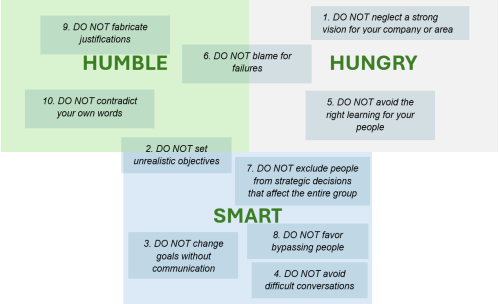Introduction
During my professional journey, I’ve had the privilege to encounter many leadership styles. These experiences revealed recurring patterns — some highly effective, others harmful. This article highlights dysfunctional behaviors I noticed leading to toxic environments. Avoiding these behaviors will help leaders foster a healthy organizational culture. The 10 DO-NOT Principles (10DNP) Theory has the aim to serve as guideline for building trust and accountability.
The 10 DO-NOT Principles
1. DO NOT neglect a strong vision for your company or area
Without a clear, inspiring vision, teams can lose direction and motivation.
INSTEAD: Regularly communicate and reinforce your vision to guide and unite your team.
2. DO NOT set unrealistic objectives
Challenging goals are good—but they must be achievable. Ignoring data that proves a goal is unattainable will damage credibility.
INSTEAD: Listen to your team’s input and adjust goals when necessary to maintain trust and motivation.
3. DO NOT change goals without communication
Changing objectives mid-year without informing your team erodes trust.
INSTEAD: Ensure goals are transparent, documented, and accessible to everyone. Communicate changes clearly and promptly.
4. DO NOT avoid difficult conversations
Leadership comes with tough discussions — whether delivering bad news, addressing uncomfortable topics, or providing feedback to others. You cannot avoid this.
INSTEAD: Face conversations with honesty and empathy, provide timely, direct feedback yourself. It shows accountability and respect.
5. DO NOT avoid the right learning for your people
Not providing the right trainings for the people or having employees paying by their own some learning experiences to grow their skills, is a failure for you as a leader.
INSTEAD: Ensure people access the needed learnings to be more effective in their job. This will let creativity flourish and people will feel more engaged.
6. DO NOT blame for failures
Failure is part of growth. Being rude or punishing others for mistakes, especially if yours, discourages learning, innovation and a psychological safe environment.
INSTEAD: Treat failures as opportunities for collective learning. Foster a culture of continuous improvement.
7. DO NOT exclude people from strategic decisions that affect the entire group
Making decisions in small, exclusive groups creates silos and mistrust.
INSTEAD: Ensure transparency and inclusivity so everyone can contribute to key decisions.
8. DO NOT favor bypassing people
Avoid creating an environment where employees skip their colleagues or people managers and come directly to you for actions.
INSTEAD: Encourage a culture where employees can have safe, constructive conversations about concerns with each other and their managers, so these ones can also grow as leaders.
9. DO NOT fabricate justifications
Avoid creating false narratives to remove someone from a role, especially when the behavior cited was evident from the start.
INSTEAD: Be transparent and fair in decision-making. Integrity builds respect.
10. DO NOT contradict your own words
Saying one thing and doing another destroys credibility.
INSTEAD: Lead by example. Align your actions with your words to earn trust.
A framework to help you as a leader
As a leader, recognizing that these pitfalls can lead to serious dysfunctions in your organization is the critical first step. Awareness alone, however, isn’t enough — action is what drives change. To effectively reduce the risk of these dysfunctions, keep front of mind the attributes Patrick Lencioni highlights in The Ideal Team Player (2016): humble, hungry, and smart. These qualities aren’t just desirable — they’re essential for building resilient, high-performing teams and leaders.
Here you have a correlation between the DNP and humble-hungry-smart attributes:

You can read the diagram as it follows: if you recognize most of the pitfalls are within a specific attribute area, it means you may at first take actions to grow in that area.
Closing Thought
Leadership is not about avoiding mistakes — it’s about creating an environment where openness, courage, respect, commitment and focus thrive and trust flourishes. By steering clear of these pitfalls, leaders can inspire teams and build resilient organizations.
